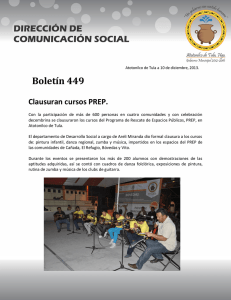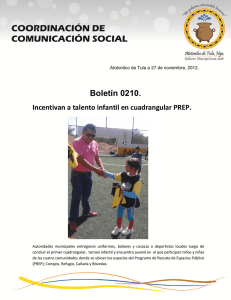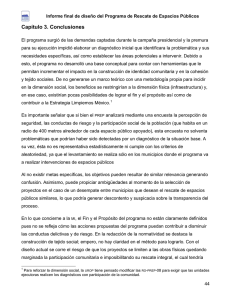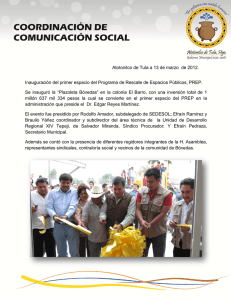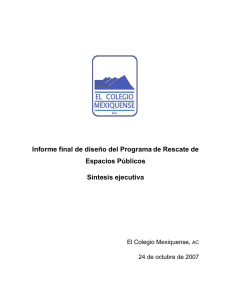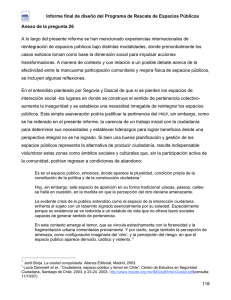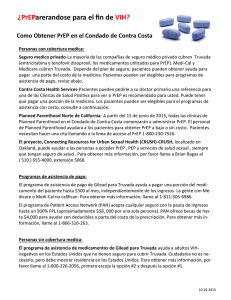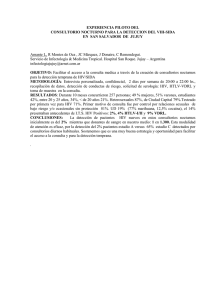Pre-exposure prophylaxis for the prevention of HIV infection: a new
Anuncio
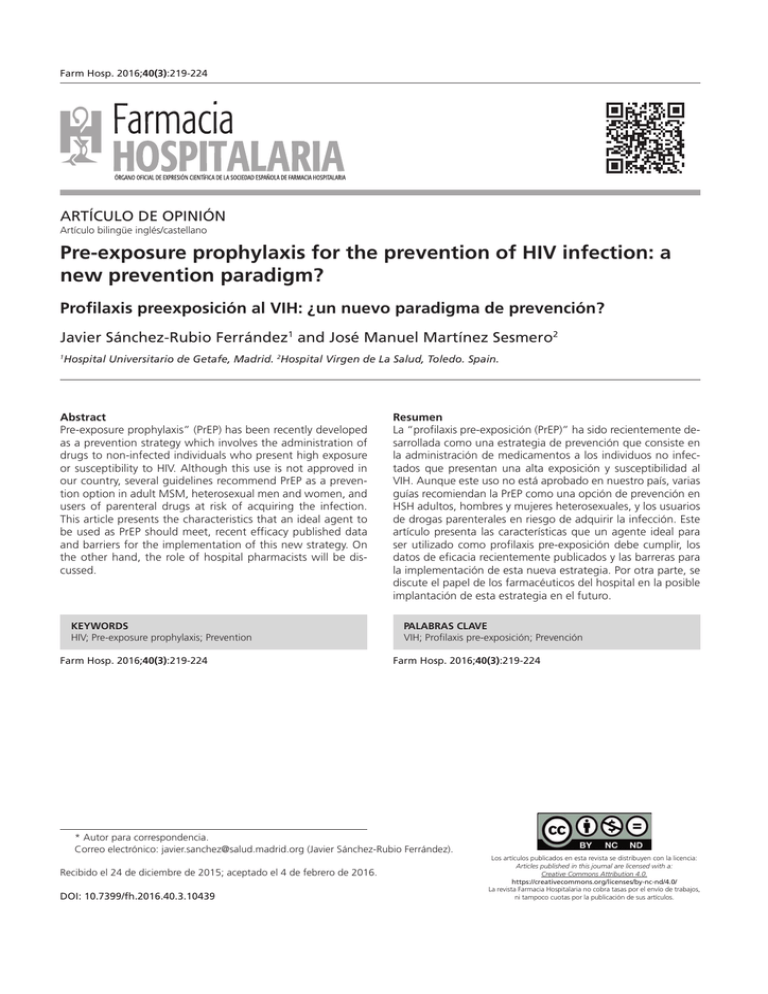
Farm Hosp. 2016;40(3):219-224 ARTÍCULO DE OPINIÓN Artículo bilingüe inglés/castellano Pre-exposure prophylaxis for the prevention of HIV infection: a new prevention paradigm? Profilaxis preexposición al VIH: ¿un nuevo paradigma de prevención? Javier Sánchez-Rubio Ferrández1 and José Manuel Martínez Sesmero2 1 Hospital Universitario de Getafe, Madrid. 2Hospital Virgen de La Salud, Toledo. Spain. Abstract Pre-exposure prophylaxis” (PrEP) has been recently developed as a prevention strategy which involves the administration of drugs to non-infected individuals who present high exposure or susceptibility to HIV. Although this use is not approved in our country, several guidelines recommend PrEP as a prevention option in adult MSM, heterosexual men and women, and users of parenteral drugs at risk of acquiring the infection. This article presents the characteristics that an ideal agent to be used as PrEP should meet, recent efficacy published data and barriers for the implementation of this new strategy. On the other hand, the role of hospital pharmacists will be discussed. KEYWORDS HIV; Pre-exposure prophylaxis; Prevention Farm Hosp. 2016;40(3):219-224 Resumen La “profilaxis pre-exposición (PrEP)” ha sido recientemente desarrollada como una estrategia de prevención que consiste en la administración de medicamentos a los individuos no infectados que presentan una alta exposición y susceptibilidad al VIH. Aunque este uso no está aprobado en nuestro país, varias guías recomiendan la PrEP como una opción de prevención en HSH adultos, hombres y mujeres heterosexuales, y los usuarios de drogas parenterales en riesgo de adquirir la infección. Este artículo presenta las características que un agente ideal para ser utilizado como profilaxis pre-exposición debe cumplir, los datos de eficacia recientemente publicados y las barreras para la implementación de esta nueva estrategia. Por otra parte, se discute el papel de los farmacéuticos del hospital en la posible implantación de esta estrategia en el futuro. PALABRAS CLAVE VIH; Profilaxis pre-exposición; Prevención Farm Hosp. 2016;40(3):219-224 * Autor para correspondencia. Correo electrónico: javier.sanchez@salud.madrid.org (Javier Sánchez-Rubio Ferrández). Recibido el 24 de diciembre de 2015; aceptado el 4 de febrero de 2016. DOI: 10.7399/fh.2016.40.3.10439 Los artículos publicados en esta revista se distribuyen con la licencia: Articles published in this journal are licensed with a: Creative Commons Attribution 4.0. https://creativecommons.org/licenses/by-nc-nd/4.0/ La revista Farmacia Hospitalaria no cobra tasas por el envío de trabajos, ni tampoco cuotas por la publicación de sus artículos. 220 - Farm Hosp. 2016;40(3):219-224 Javier Sánchez-Rubio Ferrández and José Manuel Martínez Sesmero The Human Immunodeficiency Virus (HIV) infection still represents a major health problem in our country, from the healthcare, social, economic and human points of view. The development of high-activity antiretroviral treatment has contributed to a high extent to the control and chronification of the disease, and better clinical outcomes are increasingly achieved. However, these treatments are not free of problems such as the adverse effects caused, difficulties in treatment compliance, interactions, development of resistance, the difficulty to reconcile them with the comorbidities that patients might suffer along their lives, and their associated cost. According to data available in 2013, it is estimated that in Spain there are 10.3 new diagnoses of infection per 100,000 inhabitants every year. This rate has remained stable during the 5 years previous to the analysis mentioned, though a change in trend is observed depending on type of transmission: it has reduced or become stable in parenteral drug users and heterosexual patients, and it is increasing among men who have sex with men (MSM), particularly in the 25-to-34-year-old group1. For this reason, it has become necessary to strengthen the multidisciplinary prevention policies which will allow to reduce the propagation of this disease. The so-called “pre-exposure prophylaxis” (PrEP) has been recently developed as a prevention strategy in the HIV setting. This involves the administration of drugs to non-infected individuals who present high exposure or susceptibility to this pathogen. Although this indication has not been approved for antiretroviral therapy in our country, the studies conducted so far led to the authorization by the FDA in 2012 of this use in the case of the tenofovir-emtricitabine combination. The American Center for Disease Control and Prevention (CDC) recommends PrEP as a prevention option in adult MSM, heterosexual men and women, and users of parenteral drugs at risk of acquiring the infection. On the other hand, it is considered as a possible option to be discussed with serodiscordant couples2. Moreover, the World Health Organization (WHO) has also included the use of PrEP in its recommendations for prevention in MSM and serodiscordant couples3. Some of the characteristics that an ideal agent to be used as PrEP should meet are: safety in chronic and intermittent use in different populations, good penetration in target tissues, activity against HIV, prolonged effect which allows an acceptable dosing regimen, high genetic barrier against the development of resistance, low interaction potential, if possible not being part of any existing treatment regimen, ease of use, and low economic impact4. During the last decade, different methods of this strategy have been tried in different populations at risk. Firstly, the efficacy of the use of topical tenofovir with vaginal gel formulation at 1% has been tested for PrEP. This way of administration presents the theoretical ad- vantages of higher drug concentration in the target tissue with lower systemic exposure, and therefore lower toxicity. However, despite the positive outcomes of the CAPRISA0045 clinical trial, two subsequent studies have failed to demonstrate the efficacy of this gel in the reduction of the transmission rate6,7. For this reason, the efforts for PrEP development have been turned towards the use of new formulations such as vaginal rings and anal gels, as well as systemic agents. In this sense, various studies have assessed the efficacy of the oral administration of tenofovir, alone or typically in combination with emtricitabine, as a continuous or intermittent therapy, and their outcomes have been inconsistent. Thus, the iPREX, TDF2, Partners PrEPP, Bangkok, PROUD and Ipergay studies obtained a reduction in transmission rates that could not be confirmed in the FEM-PrEP and VOICE8 trials, as shown in table 1. A detailed analysis of the studies points at lack of compliance as the main cause for the differences in outcomes found. Thus, PrEP becomes a highly effective strategy when patients reach high compliance rates, particularly among MSM; therefore, compliance of the prescribed dosing is the weak link of PrEP as a prevention strategy. The development of prolonged-release injectable agents can help to improve this aspect in future studies9. Other aspects which still generate doubts about the wide implementation of this strategy is its potential impact on the profiles of risky sexual behaviours (risk compensation), as well as on the contagion of sexually transmitted infections other than HIV. In this sense, and even though there are still limited data, studies have not shown that the application of PrEP will worsen any of these aspects in a statistically significant manner8. However, it must be taken into account that the study conditions might not reflect usual practice and that in all studies the pharmacological therapy was reinforced with educational and behaviour strategies for patients, as well as free supply of condoms. This aspect strengthens the importance of approaching prevention from different points of view, so that the application of a certain strategy should not imply a relaxation in the others, but become a complementary weapon in the fight against transmission. On the other hand, the individuals receiving these medications can be exposed to their adverse effects, still not well evaluated at long term, in the same way as patients who are taking them for disease treatment. And given that this is an antiretroviral treatment, resistance can be developed by using sub-optimal therapies in those patients who might have an unnoticed infection and initiate a PrREP regimen. Therefore, the selection of those patients who must receive this treatment, and their follow-up over time, will be another aspect required in this type of strategy. Finally, we must not forget that the drugs used for PrEP are expensive, and that extending this strategy to all the population at risk might represent a major invest- Pre-exposure prophylaxis for the prevention of hiv infection... Farm Hosp. 2016;40(3):219-224 - 221 Table 1. Outcomes of the main clinical trials on PrEP with oral agents Study Population Intervention Overall Risk Reduction Risk Reduction in Compliant Patients PROUD MSM Daily oral TDF/FTC 86% (CI95%: 58-96%) N/A IPERGAY MSM Pericoital oral TDF/FTC 86% (CI95%: 40-99%) N/A iPrEX MSM and transsexual Daily oral TDF/FTC 44% (CI95%: 15-63%) 92% (CI95%: 40-99%) Partners PrEP Heterosexual serodiscordant couples 75% (CI95%: 55-87%) 67% (CI95%: 44-81%) 90% (CI95%: 58-98%) 86% (CI95%: 67-94%) Daily oral TDF/FTC 62% (CI95%: 22-83%) 85% N/S Bangkok Tenofovir Study Parenteral drug users Daily oral TDF 49% (CI95%: 10-72%) 74% (CI95%: 2-91%) FEM-PrEP Heterosexual women Daily oral TDF/FTC 6% (CI95%: -52; 41%) N/A VOICE Heterosexual women Daily oral TDF/FTC 6.7% (CI95%: 4.7; 8.30%) N/A TDF2 Heterosexual men and women Daily oral TDF/FTC Daily oral TDF N/A: Not available; N/S: Not significant. ment of resources, at a time in which these have become very limited. However, as with any other healthcare technology, the cost-efficacy of PrEP should be closely analyzed, because the cost of each prevented infection should not be disregarded, and even more if we take into account the chronic nature of the treatment that any new infected individual would currently receive. On the other hand, and from a social perspective, an exponential increase in new infections could be prevented, leading to a reduction of other type of associated costs. All this opens the discussion about reimbursement, which will undoubtedly require an adequate critical assessment of the evidence available, and the therapeutic positioning of this strategy from the perspective of the National Health Systems. In order to clarify these controversies, we believe that the Hospital Pharmacy must undoubtedly play a major role in the discussion of PrEP implementation, which will surely be conducted within the next years; and, as in other occasions, they will need to face the challenge of a new therapeutic paradigm. On one hand, they will be involved in the preparation of protocols and guidelines which allow to determine the criteria for selecting patients who may benefit from this new method, guaranteeing its efficacy. On the other hand, as already occurs in HIV treatment, the role of the Pharmacist in terms of follow-up will be key to maintain the efficacy of these drugs by monitoring compliance, detecting and managing any potential adverse effects, providing specialized advice, and implementing educational programs in order to ensure an adequate knowledge of treatments and to prevent a shift towards other risky behaviours. Bibliography 1. Vigilancia epidemiológica del VIH/sida en España actualización 30 de junio de 2014. Sistema de información sobre nuevos diagnósticos de VIH registro nacional de casos de sida dirección general de salud pública, calidad e innovación sistemas autonómicos de vigilancia epidemiológica centro nacional de epidemiología. Noviembre, 2014 2. US Public Health Service. Preexposure Prophylaxis for the Prevention of HIV Infection in the United States – 2014 Clinical Practice Guideline. [citado Octubre 2015] Disponible en: http://www.cdc. gov/hiv/pdf/prepguidelines2014.pdf. 3. WHO: Consolidated guidelines on HIV prevention, diagnosis, treatment and care for key populations [Internet]. [citado Octubre 2015]. Disponible en: http://www.who.int/hiv/pub/guidelines/ keypopulations/en/. 4. Department of Health and Human Services. Next Generation PrEP II (R01). 2011 [Monografía Internet]. [citado Octubre 2015]. Disponible en: http://grants.nih.gov/grants/guide/rfa-files/RFA-AI-11-023.html. 5. Abdool Karim Q, Abdool Karim SS, Frohlich JA, Grobler AC, Baxter C, Mansoor LE, et al. CAPRISA 004 trial Group. Effectiveness and safety of tenofovir gel, an antiretroviral microbicide, for the prevention of HIV infection in women.Science. 2010 Sep 3;329(5996):1168-74. 6. Marrazzo JM, Ramjee G, Richardson BA, Gomez K, Mgodi N, Nair G, et al. VOICE Study Team.Tenofovir-based preexposure prophylaxis for HIV infection among African women. N Engl J Med. 2015 Feb 5;372(6):509-18. 7. Rees H, Delany-Moretlwe, Lombard C, Baron D, Panchia R, Myer L et al.. FACTS 001: a multi-centred phase III randomised, double-blind, placebo controlled trial of pericoital tenofovir 1% gel for HIV prevention in women. CROI 2015. 8. Spinner CD, Boesecke C, Zink A, Jessen H, Stellbrink HJ, Rockstroh JK, et al. HIV pre-exposure prophylaxis (PrEP): a review of current knowledge of oral systemic HIV PrEP in humans. Infection. 2015 Oct 15. [Epub ahead of print]. 9. Markowitz M, Meyers K. Extending access with long-acting antiretroviral therapy: the next advance in HIV-1 therapeutics and prevention. Curr Opin HIV AIDS. 2015 Jul;10(4):216-8. 222 - Farm Hosp. 2016;40(3):219-224 Javier Sánchez-Rubio Ferrández and José Manuel Martínez Sesmero La infección por el virus de la inmunodeficiencia humana (VIH) continúa siendo un problema de salud de primera magnitud en nuestro país desde el prisma sanitario, social, económico y humano. El desarrollo del tratamiento antirretroviral de gran actividad ha contribuido enormemente al control y la cronificación de la enfermedad, obteniéndose cada vez mejores resultados clínicos. Sin embargo, estos tratamientos no están exentos de problemas como son los efectos adversos que se producen, las dificultades de adherencia, las interacciones, el desarrollo de resistencias, la dificultad de compatibilizarlos con las comorbilidades que pueden afectar al paciente a lo largo de su vida y el coste asociado. Según los datos disponibles del año 2013, en España se estima que se producen 10,3 nuevos diagnósticos de infección por cada 100000 habitantes al año. Esta tasa se ha mantenido estable en los 5 años previos de análisis citado, aunque se observa un cambio de tendencia según la categoría de transmisión, disminuyendo o estabilizándose en usuarios de drogas por vía parenteral y heterosexuales y aumentando entre los hombres que tienen sexo con hombres (HSH), especialmente en el grupo de 25 a 34 años1. Por este motivo, se hace necesaria la potenciación de las políticas de prevención multidisciplinares que permitan disminuir la propagación de esta enfermedad. Recientemente se ha desarrollado como estrategia de prevención la denominada “profilaxis preexposición” (PrEP) en el ámbito del VIH que consiste en la administración de fármacos a individuos no infectados que tienen una elevada exposición o vulnerabilidad a este patógeno. Aunque esta indicación no está reconocida para la terapia antiretroviral en nuestro país, los estudios realizados hasta el momento conllevaron la autorización en 2012 de este uso en el caso de la combinación tenofovir-emtricitabina por la FDA. El Center for Disease Control and Prevention (CDC) americano recomienda la PrEP como una opción de prevención en HSH adultos, hombres y mujeres heterosexuales y usuarios de drogas por vía parenteral en riesgo de adquisición de la infección. Por otro lado se considera una posible opción a discutir con parejas serodiscordantes2. Por su parte la Organización Mundial de la Salud (OMS) también incluye el uso de PrEP en sus recomendaciones de prevención para HSH y parejas serodiscordantes3. Las características que un agente ideal para su utilización como PrEP debería cumplir, incluyen la seguridad en el uso crónico y episódico en distintas poblaciones, buena penetración en los tejidos diana, actividad frente al VIH, efecto prolongado que permita un régimen de dosificación asumible, alta barrera genética frente al desarrollo de resistencias, escaso potencial de interacción, a ser posible no formar parte de los regímenes de tratamiento existentes, ser fácil de usar y de bajo impacto económico4. Durante la última década se han ensayado varias modalidades de esta estrategia en diferentes poblaciones de riesgo. En primer lugar se ha analizado la eficacia del uso de tenofovir tópico formulado como gel vaginal al 1% en la PrEP. Esta vía presenta las ventajas teóricas de una mayor concentración del fármaco en el tejido diana con una menor exposición sistémica y por tanto menor toxicidad. Sin embargo a pesar de los resultados positivos del ensayo CAPRISA0045, dos estudios posteriores han fallado en demostrar la eficacia del gel en la disminución de la tasa de transmisión6,7. Por este motivo los esfuerzos en el desarrollo de la PrEP se han desplazado al uso nuevas formulaciones como los anillos vaginales y los geles anales, así como los de agentes sistémicos. En este sentido varios estudios han evaluado la eficacia de la administración oral de tenofovir, sólo o generalmente combinado con emtricitabina, de manera continua o intermitente, con resultados dispares. Así los estudios iPREX, TDF2, Partners PrEPP, Bangkok, PROUD e Ipergay obtuvieron una disminución de las tasas de transmisión que no pudieron constatarse en los estudios FEM-PrEP y VOICE8 tal y como se refleja en la tabla 1) El análisis detallado de los estudios señala a la falta de adherencia como la principal causa de las diferencias de resultado encontradas. Así, la PrEP se torna en una estrategia de eficacia muy elevada cuando los pacientes alcanzan tasas de adherencia elevadas, especialmente en HSH, siendo por tanto el cumplimiento de la pauta prescrita el talón de Aquiles de la PrEP como estrategia para la prevención. El desarrollo de agentes inyectables de larga duración puede contribuir a mejorar este aspecto en futuros estudios9. Otros aspectos que generan aún dudas sobre la generalización de la aplicación de esta estrategia es su posible impacto sobre los perfiles de comportamiento sexual de riesgo (compensación de riesgo), así como sobre la transmisión de otras infecciones de transmisión sexual diferentes al VIH. En este sentido y aunque los datos aún son escasos, los estudios no han revelado que la aplicación de PrEP empeore cualquiera de estos dos aspectos de manera estadísticamente significativa8. Sin embargo, debe tenerse en cuenta que las condiciones de los estudios pueden no reflejar la práctica habitual, y que en todos ellos la terapia farmacológica se acompañaba de estrategias educativas y de refuerzo conductual al paciente así como suministro gratuito de preservativos. Este aspecto refuerza la importancia del abordaje de la prevención desde diferentes puntos de vista de manera que la aplicación de una determinada estrategia no debe implicar una relajación en las demás si no ser un arma complementaria en la lucha contra la transmisión. Por otro lado, los individuos que reciban estos medicamentos pueden estar expuestos a efectos adversos de los mismos, aún poco evaluados a largo plazo, de la misma manera que los pacientes que los toman para el tra- Pre-exposure prophylaxis for the prevention of hiv infection... Farm Hosp. 2016;40(3):219-224 - 223 Tabla 1. Resultados de los principales estudios sobre PrEP con agentes orales Estudio Población Intervención Reducción global del riesgo Reducción del riesgo en pacientes adherentes PROUD HSH TDF/FTC oral diario 86% (IC95%: 58-96%) ND IPERGAY HSH TDF/FTC oral pericoital 86% (IC95%: 40-99%) ND iPrEX HSH y transexual TDF/FTC oral diario 44% (IC95%: 15-63%) 92% (IC95%: 40-99%) Partners PrEP Parejas heterosexuales serodiscordantes 75% (IC95%: 55-87%) 67% (IC95%: 44-81%) 90% (IC95%: 58-98%) 86% (IC95%: 67-94%) TDF/FTC oral diario TDF oral diario TDF2 Hombres y mujeres heterosexuales TDF/FTC oral diario 62% (IC95%: 22-83%) 85% ns Bangkok Tenofovir Study Usuarios a drogas parenterales TDF oral diario 49% (IC95%: 10-72%) 74% (IC95%: 2-91%) FEM-PrEP Mujeres heterosexuales TDF/FTC oral diario 6% (IC95%: -52; 41%) ND VOICE Mujeres heterosexuales TDF/FTC oral diario 6,7% (IC95%: 4,7; 8,30%) ND ND: No disponible; ns: no significativo tamiento de la enfermedad, y al tratarse de tratamiento antirretroviral podrían desarrollarse resistencias al aplicar terapias subóptimas en aquellos pacientes que teniendo una infección inadvertida iniciaran un régimen PrREP. Por lo tanto la selección de los pacientes que deben recibir este tratamiento y el seguimiento de los mismos a lo largo del tiempo será otro de los aspectos necesarios en este tipo de estrategia. Finalmente, no debe olvidarse que los fármacos empleados en la PrEP presentan un coste elevado y que la extensión de esta estrategia a toda la población de riesgo puede suponer una importante inversión de recursos en una época en la que existe verdadera escasez de los mismos. Sin embargo, como cualquier otra tecnología sanitaria, se debería analizar el coste-efectividad de la PrEP de manera rigurosa pues el coste de cada infección evitada no es nada desdeñable máxime si se tiene en cuenta el carácter crónico del tratamiento que en el momento actual recibiría cualquier nuevo individuo infectado. Por otro lado, y desde un punto de vista social, podrían evitarse nuevas infecciones que podrían producirse de manera exponencial, aumentando otro tipo de costes asociados. Todo esto abre el debate de la financiación, que sin duda necesitará de una adecuada evaluación crítica de la evidencia disponible y el posicionamiento terapéutico de esta estrategia desde el punto de vista de los Sistemas Nacionales de Salud. Para dilucidar estas controversias creemos que el farmacéutico de hospital ha de jugar sin duda un papel muy importante en el debate de la implantación de la PrEP que a buen seguro se producirá en los próximos años y como en otras ocasiones deberá afrontar el reto de un nuevo paradigma terapéutico. Por un lado deberá participar en la elaboración de protocolos y guías que permitan determinar los criterios de selección de los pacientes que puedan beneficiarse de esta nueva modalidad garantizando la eficiencia. Por otro, como lo es ya en el tratamiento del VIH, el papel del farmacéutico en el seguimiento será clave para mantener la efectividad de estos fármacos mediante el control de la adherencia, detección y manejo de los posibles efectos adversos, consejo especializado e implementación de programas educativos que garanticen el correcto conocimiento de los tratamientos y que impidan el desplazamiento hacia otros comportamientos de riesgo. Bibliografía 1. Vigilancia epidemiológica del VIH/sida en España actualización 30 de junio de 2014. Sistema de información sobre nuevos diagnósticos de VIH registro nacional de casos de sida dirección general de salud pública, calidad e innovación sistemas autonómicos de vigilancia epidemiológica centro nacional de epidemiología. Noviembre, 2014 2. US Public Health Service. Preexposure Prophylaxis for the Prevention of HIV Infection in the United States – 2014 Clinical Practice Guideline. [citado Octubre 2015] Disponible en: http://www.cdc. gov/hiv/pdf/prepguidelines2014.pdf. 3. WHO: Consolidated guidelines on HIV prevention, diagnosis, treatment and care for key populations [Internet]. [citado Octubre 2015]. Disponible en: http://www.who.int/hiv/pub/guidelines/ keypopulations/en/. 4. Department of Health and Human Services. Next Generation PrEP II (R01). 2011 [Monografía Internet]. [citado Octubre 2015]. Disponible en: http://grants.nih.gov/grants/guide/rfa-files/RFA-AI-11-023.html. 5. Abdool Karim Q, Abdool Karim SS, Frohlich JA, Grobler AC, Baxter C, Mansoor LE, et al. CAPRISA 004 trial Group. Effecti- 224 - Farm Hosp. 2016;40(3):219-224 Javier Sánchez-Rubio Ferrández and José Manuel Martínez Sesmero veness and safety of tenofovir gel, an antiretroviral microbicide, for the prevention of HIV infection in women.Science. 2010 Sep 3;329(5996):1168-74. 6. Marrazzo JM, Ramjee G, Richardson BA, Gomez K, Mgodi N, Nair G, et al. VOICE Study Team.Tenofovir-based preexposure prophylaxis for HIV infection among African women. N Engl J Med. 2015 Feb 5;372(6):509-18. 7. Rees H, Delany-Moretlwe, Lombard C, Baron D, Panchia R, Myer L et al.. FACTS 001: a multi-centred phase III randomised, dou- ble-blind, placebo controlled trial of pericoital tenofovir 1% gel for HIV prevention in women. CROI 2015. 8. Spinner CD, Boesecke C, Zink A, Jessen H, Stellbrink HJ, Rockstroh JK, et al. HIV pre-exposure prophylaxis (PrEP): a review of current knowledge of oral systemic HIV PrEP in humans. Infection. 2015 Oct 15. [Epub ahead of print]. 9. Markowitz M, Meyers K. Extending access with long-acting antiretroviral therapy: the next advance in HIV-1 therapeutics and prevention. Curr Opin HIV AIDS. 2015 Jul;10(4):216-8.
